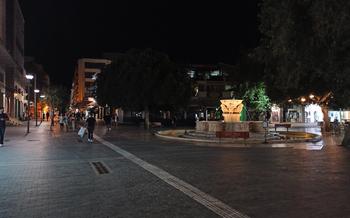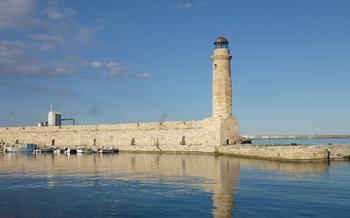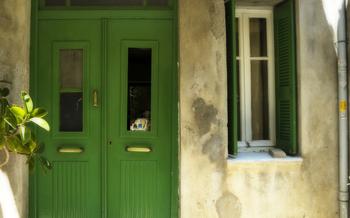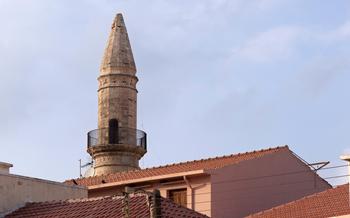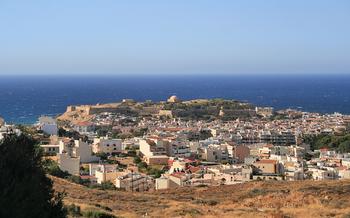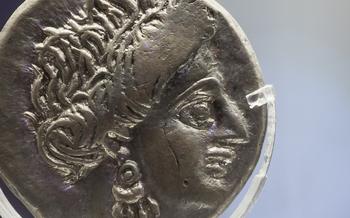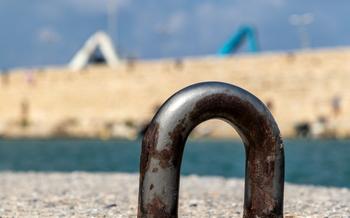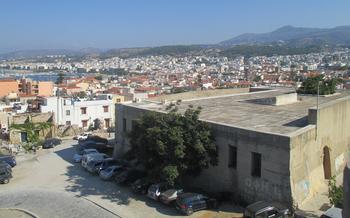
The Great Door (Megali Porta)
- History of the Great Door (Megali Porta)
- Location and Accessibility
- Architectural Features
- Historical Significance
- Visitor Information
- Legends and Folklore
- Nearby Attractions
- Photo Opportunities
- Best Time to Visit
- Accessibility for Different Travelers
- Safety and Security
- Sustainable Travel Practices
- Insider Tip
History of the Great Door (Megali Porta)
In the heart of the captivating Venetian city of Rethymno, a remarkable architectural masterpiece stands as a testament to its rich past - the Great Door (Megali Porta). This colossal gateway, also known as the Porta Guora, was meticulously crafted during the Venetian rule in the 16th century. Its strategic placement at the heart of the city's mighty fortifications served as the main entrance to the fortified city, connecting it to the bustling commercial hub beyond its walls.
The Great Door, a marvel of Venetian engineering, showcases a harmonious blend of architectural styles, reflecting the diverse influences that shaped Rethymno's history. Its imposing facade is a testament to the city's resilience and strength, as it withstood numerous attacks and sieges throughout the centuries. Step through this magnificent portal, and you'll be transported back in time, surrounded by the tangible remnants of a glorious era.
Location and Accessibility
The Great Door (Megali Porta) is strategically positioned at the heart of Rethymno's Old Town. It stands on Eleftheriou Venizelou Street, a bustling pedestrianized thoroughfare lined with shops, restaurants, and historical buildings. The door is easily accessible by foot, as it is within walking distance from the city center, the Venetian Harbor, and other major attractions.
For those arriving by car, there are several nearby parking lots. Visitors can also opt for public transportation, as the city bus network has stops close to the door. Rethymno is well-connected to other parts of Crete, making it easy to reach by bus or rental car.
The Great Door is accessible for individuals with disabilities. There is a ramp leading up to the door, and the entrance is wide enough to accommodate wheelchairs. Inside the door, the ground is level, making it easy to navigate for those with limited mobility.
Architectural Features
Architecturally, the Great Door is a remarkable example of Venetian fortifications. It features a massive, arched entranceway flanked by two imposing towers. The door is constructed of sturdy stone, ensuring its durability and strength. Its walls are adorned with intricate carvings and decorative elements, showcasing the craftsmanship and artistry of the Venetian builders. The door's design is both functional and aesthetically pleasing, blending defensive capabilities with architectural beauty. Similarities can be seen with other Venetian fortifications in Crete and throughout the Mediterranean, reflecting the shared architectural heritage of the Venetian Empire. However, the Great Door also exhibits unique features, such as its intricate carvings and the positioning of its towers, making it a distinct and significant landmark in Rethymno.
Historical Significance
The Great Door (Megali Porta) of Rethymno, constructed in the 16th century, played a pivotal role in the city's defense during the Venetian period. As the main entrance to the fortified city, it bore witness to numerous battles and sieges.
One of the most significant events associated with the door occurred in 1571, when the Ottoman forces attempted to capture Rethymno as part of their broader campaign to conquer Crete. The city's defenders, led by Venetian commander Alvise Contarini, managed to repel the Ottoman attack, and the door played a crucial role in their victory.
Throughout its history, the door served as a symbol of Rethymno's strength and resilience. It stood as a testament to the city's ability to withstand attacks and invasions. Several historical figures are connected to the door, including Alvise Contarini, who played a key role in its defense, and Francesco Morosini, a Venetian admiral who led the successful recapture of Rethymno from the Ottomans in 164
Visitor Information
Opening Hours and Admission Fees
The Great Door (Megali Porta) is open to the public daily, except for major holidays. The opening hours are typically from 8:00 AM to 8:00 PM during the summer season (April to October) and from 9:00 AM to 5:00 PM during the winter season (November to March). Admission to the door is free of charge, allowing visitors to explore and admire this historical landmark without any financial burden.
Guided Tours and Audio Guides Available
To enhance your visit, guided tours and audio guides are available for those who wish to delve deeper into the history and significance of the Great Door. Guided tours are conducted by knowledgeable local experts who provide insightful commentary and anecdotes about the door's past. Audio guides are also available in multiple languages, offering a self-guided tour experience with detailed information at your fingertips.
Tips for Planning a Visit
When planning your visit to the Great Door, remember to wear comfortable shoes as you'll be doing a lot of walking. The door is located in the heart of Rethymno's Old Town, so it's easily accessible on foot or by bicycle. If you're driving, there are several parking options available nearby. It's also worth noting that the door is illuminated at night, creating a magical ambiance that's perfect for evening strolls.
Combination Tickets with Other Attractions
To make the most of your time in Rethymno, consider purchasing a combination ticket that includes admission to the Great Door and other popular attractions in the city. This can save you money and allow you to visit multiple sites conveniently.
Legends and Folklore
The Great Door (Megali Porta) is steeped in local myths and stories that have been passed down through generations. One legend tells of a beautiful young woman who was captured by pirates and taken to the door. She was imprisoned in the tower above the door, where she wept and cried until her tears turned to stone. Visitors to the door can still see the marks of her tears on the stone walls.
Another legend tells of a ghostly figure that haunts the door. The figure is said to be the spirit of a Venetian soldier who was killed in battle. He is said to appear on the anniversary of his death, searching for his lost love.
These legends and stories add to the mystique of the Great Door (Megali Porta) and make it a fascinating place to visit. They remind us of the long and rich history of Rethymno and the many stories that these ancient walls could tell.
Nearby Attractions
Rethymno boasts a wealth of attractions within easy reach of the Great Door (Megali Porta). Immerse yourself in history at the Rethymno Archaeological Museum, showcasing artifacts from the city's rich past. Wander through the enchanting Venetian Harbor, lined with colorful buildings, charming cafes, and traditional tavernas. Explore the Fortezza of Rethymno, an imposing Venetian fortress offering panoramic city views. Step back in time at the Historical and Folklore Museum of Rethymno, providing insights into the city's cultural heritage. For a tranquil escape, stroll through the Municipal Garden of Rethymno, a verdant oasis filled with lush vegetation and serene pathways. Don't miss the Rimondi Fountain, an iconic Venetian monument symbolizing the city's water supply. For those seeking adventure, embark on a scenic hike to the Arkadi Monastery, a historic site nestled amidst picturesque landscapes. With so much to discover, Rethymno offers a captivating blend of history, culture, and natural wonders.
Photo Opportunities
The Great Door (Megali Porta) of Rethymno, with its imposing architecture and historical significance, makes for a captivating subject for photography enthusiasts. Here are some tips for capturing stunning shots of this iconic landmark:
Ideal Spots: - Front View: Position yourself directly in front of the door to capture its full grandeur. - Side View: Explore the side angles to highlight the door's intricate details and carvings. - Elevated View: Head to the nearby ramparts for a bird's-eye perspective.
Tips for Memorable Shots: - Golden Hour Magic: Plan your visit during the golden hours of sunrise or sunset for warm, diffused lighting. - Composition: Play with different angles and compositions to create visually interesting shots. - Storytelling Elements: Include people or objects to add a sense of scale and human connection.
Photography Restrictions: - Respect Signs: Be mindful of any signs or restrictions regarding photography. - Privacy: Avoid photographing people without their consent.
Sharing Your Photos: - Social Media: Share your captivating shots on social media, using relevant hashtags like #Rethymno, #MegaliPorta, and #VenetianFortifications. - Travel Blogs: If you have a travel blog, consider featuring your photos in a blog post about your Rethymno adventures.
Best Time to Visit
The best time to visit the Great Door (Megali Porta) is during the shoulder seasons, which fall between April and May, and September and October. During these months, the weather is pleasant and warm, with average temperatures ranging from 20 to 25 degrees Celsius. The crowds are also smaller, making it easier to explore the door and the surrounding area without feeling overwhelmed.
Summer months, from June to August, can be hot and crowded, especially during the peak tourist season in July and August. While the weather is ideal for swimming and sunbathing, it can be uncomfortable for sightseeing and walking around the city. If you do visit during the summer, be sure to bring plenty of water, sunscreen, and a hat to protect yourself from the sun.
Winter months, from November to March, can be cold and rainy, with temperatures dropping to around 10 degrees Celsius. While the door is still open to visitors during this time, some of the nearby attractions may be closed or have reduced hours. If you're visiting during the winter, be sure to check the weather forecast and pack accordingly.
No matter what time of year you choose to visit, the Great Door (Megali Porta) is a must-see for anyone interested in history, architecture, and culture. With its stunning beauty and rich historical significance, it's an attraction that you won't want to miss.
Accessibility for Different Travelers
The Great Door is accessible to visitors with disabilities, ensuring an inclusive and enjoyable experience for all. There are ramps and designated pathways that allow wheelchair users and individuals with limited mobility to explore the site. Strollers can also be accommodated, making it a family-friendly destination. Alternative routes and options are available for those who require assistance or prefer a different path. The staff is friendly and accommodating, ready to provide any necessary assistance or information to ensure a comfortable and memorable visit for all.
Safety and Security
Navigating Rethymno and exploring the Great Door should not pose any significant safety concerns. Nevertheless, it's essential to exercise common sense and adopt precautionary measures to ensure a safe and enjoyable visit.
- Be aware of your surroundings and belongings, especially in crowded areas.
- Avoid walking alone at night, particularly in dimly lit streets.
- Choose licensed and reputable tour operators for excursions and activities.
- Respect local customs and traditions to prevent causing offense or misunderstandings.
- Keep a copy of your travel documents and essential contact information safe.
- Familiarize yourself with emergency numbers and seek assistance if needed.
In case of an emergency, dial 112, the European emergency number, which will connect you to the appropriate services. For tourist-related assistance, you can contact the Rethymno Tourist Police at (+30) 28310 22714 or the Hellenic Police at (+30) 28310 50000.
Sustainable Travel Practices
As a responsible traveler, it's important to minimize your environmental impact while exploring Rethymno and its attractions. Here are some sustainable travel practices to consider:
-
Opt for walking or cycling: Rethymno's compact size makes it easy to explore on foot or by bicycle. This reduces carbon emissions and allows you to soak in the city's charm at a slower pace.
-
Choose local transportation: When traveling longer distances, use public transportation or local taxis instead of renting a car. This supports local businesses and helps reduce traffic congestion.
-
Stay in eco-friendly accommodations: Look for hotels or guesthouses that prioritize sustainability, such as those using renewable energy sources or implementing water conservation measures.
-
Support local businesses: Shop at local markets, dine at traditional tavernas, and buy souvenirs from local artisans. This helps preserve the city's unique character and supports the local economy.
-
Respect the environment: Be mindful of your waste and dispose of it properly. Avoid littering and respect the natural surroundings by staying on designated paths and trails.
By embracing sustainable practices, you can contribute to preserving Rethymno's rich heritage and ensuring its beauty for future generations.
Insider Tip
Beyond the historical allure of the Great Door, venture into the narrow cobbled streets that radiate from the Old Town. Explore the hidden gems, such as the secluded Agios Fragkiskos Church, with its captivating frescoes and serene atmosphere. Discover the charming Venetian mansions, adorned with intricate carvings and colorful facades, that line the picturesque streets. Take a moment to savor the authentic flavors of Rethymno's cuisine at a traditional taverna, where you can indulge in mouthwatering dishes prepared with fresh, local ingredients. Embrace the local culture by joining a traditional dance class or learning about the art of Cretan pottery. These unique experiences will provide you with an unforgettable glimpse into the heart and soul of this historic city.

